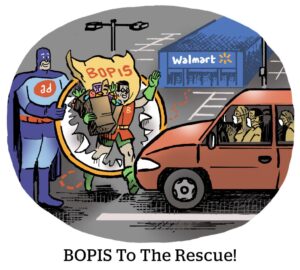After Walmart and Target reported their Q3 earnings this week, the former’s shares jumped 7% and the latter’s dropped 14% – and yet both retailers had a similar warning for investors.
Target and Walmart expect a modest Q4 and spoke of early signs that consumers are dramatically changing their shopping patterns (yet again).
One investor asked Target’s leadership whether consumer trade-downs and spending reductions are driven by sentiment, and therefore may easily reverse.
Unfortunately, though, there’s nowhere to hide, according to Target EVP and COO John Mulligan.
“The syndicated data across all retail indicates that in the first week of November general merchandise contracted by 14%,” he said. “It’s a very significant change in shopping behavior.”
Walmart says it’s equipped to catch shoppers looking for value – which is to say, it’s cheaper, and it’s seeing the same trend.
Walmart’s private label lines, which are generally the cheapest item on the shelf (the private-label mustard will be cheaper than Hellmann’s or French’s branded mustard, for example) have been flat for three years, said John Furner, Walmart’s president and CEO.
And then, in March of this year, consumers started moving from consumer brands to Walmart private label brands.
Food and bev
Private-label food sales are a focus right now because grocery staples are an important metric for Walmart and Target.
Christina Hennington, Target’s EVP and chief growth officer, said there are three “inflection points” that Target believes contribute significantly to customers spending more of their overall wallet with Target across categories.
First is when they become an “omnichannel guest.” As in, they shop on the site as well as in the store or the download the Target app. Also important are whether they use multiple fulfillment methods (home delivery, store pickup and/or in-store shopping) and whether they’re grocery shoppers.
“Those three are each growing faster than Target overall,” Hennington said. If Target sees growth in any if those inflection points, the company has confidence that it can increase the value of its shoppers without adding customers. Customer acquisition is almost always more expensive that retention.
Food and beverage sales are also deeply enmeshed with advertising revenue – which is no surprise, considering we’re talking about big CPG brands.
For instance, Hennington said Target guests are “holding out for and expecting promotions more than ever.”
Just like with Amazon, a brand seller that works with the Walmart Connect or Target Roundel platform can either spend more to place items in sponsored ad units or increase their visibility on the platform by lowering their prices. That’s why Walmart’s advertising revenue, which the company breaks out in earnings reports only once per year, can be recorded either as net sales or as a reduction to cost of sales.
The inflationary pressures and private-label trends also create more ways for name brands to work with retailers on co-marketing plans.
Thanksgiving meals are the go-to example for these partnerships, said Walmart CEO Doug McMillon. Walmart has a 17-item assortment for $71. “Some of these are branded items,” he said. “I think that’s a great example of how we can step up and absorb some of this to help families that need it most.”
Target, meanwhile, is promoting a seven-item Thanksgiving spread for $25, most of which are private-label products, but with a couple Kraft Heinz items in the mix.
Omni-growth
Being an omnichannel retailer is an expensive priority at the moment. Stores must be retrofitted for same-day delivery and pick-up, and more store associates must be hired and quickly trained.
Still, the payoff can be great, both Walmart and Target told investors.
“One of the things that excites me the most about this business is the opportunity that we have going forward with a changing business model that is really reflective of where consumer patterns are shifting to,” said Walmart EVP and financial chief John David Rainey.
In short, people are shopping online and cross-channel, and that’s favorable to Walmart’s profit margin.
Historically, Walmart execs and investors discussed the relative value of in-store shoppers versus online shoppers, Rainey said. But now the focus is all on the acceleration of Walmart’s share of the overall wallet when someone becomes an ecommerce, pick-up and in-store shopper.
“A lot of people may come to us for Tide or come to us for bananas, but they may not buy a t-shirt or a sweater,” McMillon said. However, it seems to be the case that when customers have a hybrid approach between ecommerce and store shopping, they consolidate more of their purchases with one retailer.
Target is also prioritizing cross-channel shopping. One of its strongest digital engagement investments right now is the expansion of Starbucks to its drive-up shopping experience. Curbside Starbucks is one of the top requests Target gets from its customers (whom it calls “guests,” whereas Walmart dubs its shoppers “members”).
“I’m getting milk and diapers, why can’t I get my latte as well?” Mulligan said.
Digital sales represented 20% of Target’s overall business in Q3, while Walmart’s ecommerce penetration was 23%. But brick-and-mortar stores are fulfilling more than 90% of sales for each.
Retailers want to keep store fulfillment high while simultaneously growing ecommerce as a share of overall sales – which is good news for ad platform investments.
“When you consider things like advertising or fulfillment services,” Rainey said, “these are areas of our business that not only are faster-growing, but have a higher margin associated with them.”
And higher-margin revenue streams is what Wall Street wants to see, if retailers are going to prioritize low margins on groceries for the sake of customer growth.
“Hopefully, we look up a number of years from now and we’ve got a much more diverse and durable earnings stream,” Rainey said. “Also, that there’s a different multiple ascribed to those earning streams than what exists today.”












